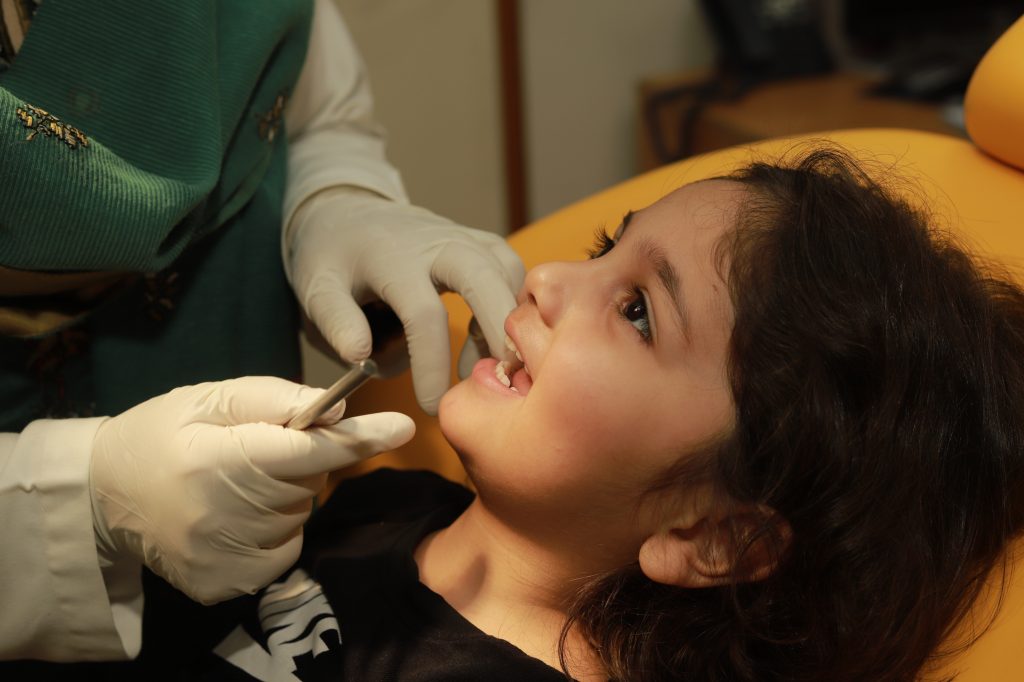Paediatric Dentistry
Introduction
Welcome to the world of Paediatric Dentistry, where we specialize in examining, managing, and treating dental issues in children. Our dedicated team of experts strives to safeguard children’s smiles throughout their formative years and foster a lifelong commitment to oral health. We understand that dental procedures can be daunting, so we create a warm and welcoming atmosphere to ease children’s fears. We emphasize regular check-ups for milk teeth, using the latest techniques in preventive and operative dentistry, orthodontics, and periodontal therapy. Our goal is to make dental care a delightful experience and improve the oral health of every child.
Services
The Department of Operative Dentistry offers a comprehensive range of services to ensure the best possible care for our patients. Our dedicated team of dental professionals specializes in the following treatments:
Fluoride Varnishes
Fluoride varnish is a dental treatment that involves applying a concentrated fluoride solution to the teeth. It is a preventive measure used to strengthen tooth enamel and protect against tooth decay.
Fillings
Fillings are commonly used to treat early childhood caries, which is the most prevalent disease in children. If necessary, extractions may also be performed. Fillings help restore decayed teeth and prevent further damage.
Orthodontic Extraction Therapy
Orthodontic extraction therapy is a treatment in orthodontics where specific teeth are strategically removed to create space for proper alignment. It is used to address crowding or limited space in the dental arch, resulting in improved bite function and aesthetics. The decision for extraction is made after careful evaluation and treatment planning by the orthodontist.
Orthodontic Extraction Therapy
Orthodontic extraction therapy is a treatment in orthodontics where specific teeth are strategically removed to create space for proper alignment. It is used to address crowding or limited space in the dental arch, resulting in improved bite function and aesthetics. The decision for extraction is made after careful evaluation and treatment planning by the orthodontist.

Pulp Therapy
Pulp therapy, also known as vital pulp therapy (VPT), aims to preserve and maintain compromised pulp tissue in a healthy state. It is used when the pulp has been affected by caries, trauma, or restorative procedures, particularly in young adult teeth with incomplete root development.
Root Canal Treatment
Root canal treatment (RCT) is an effective and safe way to clean an infection in an abscessed tooth and its roots. It involves removing infected or damaged pulp, cleaning the root canals, and sealing them to prevent further infection.
Root Canal Treatment
Root canal treatment (RCT) is an effective and safe way to clean an infection in an abscessed tooth and its roots. It involves removing infected or damaged pulp, cleaning the root canals, and sealing them to prevent further infection.

Apexification
Apexification is a dental treatment for immature permanent teeth with necrotic pulp. It involves removing the infected pulp, cleaning the root canal, and placing medication to promote the formation of a calcific barrier near the root apex. This strengthens the root, prevents infection, and preserves the tooth.
Common Dental Disorders
The disorders we treat in the department of Paediatric Dentistry at RMI include:
1- Early Childhood Caries (ECC):
ECC is tooth decay in children aged from birth to 71 months. It appears as white spots at the gum line and can cause deterioration of primary teeth. We specialize in treating ECC using fillings and extractions.
2- Acute/Chronic Pulpitis:
Pulpitis is inflammation of the dental pulp. Acute pulpitis is sudden and severe, often caused by decay or trauma, while chronic pulpitis progresses gradually. Prompt dental intervention is crucial to alleviate symptoms and preserve the affected tooth.
3- Dental Trauma:
Dental trauma refers to injuries to the teeth, gums, and surrounding soft tissues. It includes fractures, displacement, and avulsion. Treatment options depend on the severity of the injury and may include smoothing tooth surfaces, pulp treatment, repositioning displaced teeth, or reimplanting avulsed teeth.
4- Supernumerary Teeth (ST):
Supernumerary teeth are extra teeth that can develop abnormally along other teeth. They can lead to dental issues and may require removal to prevent complications.
5- Delayed Tooth Eruption (DTE):
DTE refers to the late growth of primary or permanent teeth. It can be caused by various factors, including insufficient space in the dental arch or dental infections.
The disorders we treat in the department of Paediatric Dentistry at RMI include:
Early Childhood Caries (ECC):
ECC is tooth decay in children aged from birth to 71 months. It appears as white spots at the gum line and can cause deterioration of primary teeth. We specialize in treating ECC using fillings and extractions.
Acute/Chronic Pulpitis:
Pulpitis is inflammation of the dental pulp. Acute pulpitis is sudden and severe, often caused by decay or trauma, while chronic pulpitis progresses gradually. Prompt dental intervention is crucial to alleviate symptoms and preserve the affected tooth.
Dental Trauma:
Dental trauma refers to injuries to the teeth, gums, and surrounding soft tissues. It includes fractures, displacement, and avulsion. Treatment options depend on the severity of the injury and may include smoothing tooth surfaces, pulp treatment, repositioning displaced teeth, or reimplanting avulsed teeth.
Supernumerary Teeth (ST):
Supernumerary teeth are extra teeth that can develop abnormally along other teeth. They can lead to dental issues and may require removal to prevent complications.
Delayed Tooth Eruption (DTE):
DTE refers to the late growth of primary or permanent teeth. It can be caused by various factors, including insufficient space in the dental arch or dental infections.
Dentists
Our dedicated team of oral and maxillofacial surgeons, along with our advanced technology and comprehensive approach, ensures that patients receive the highest standard of care for their specific needs and conditions.


